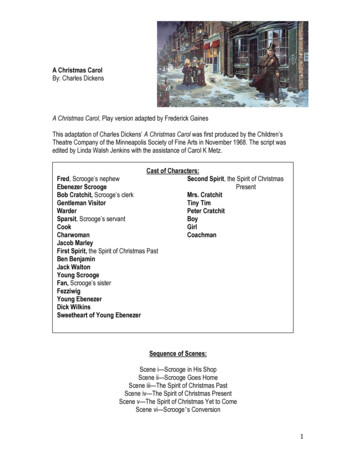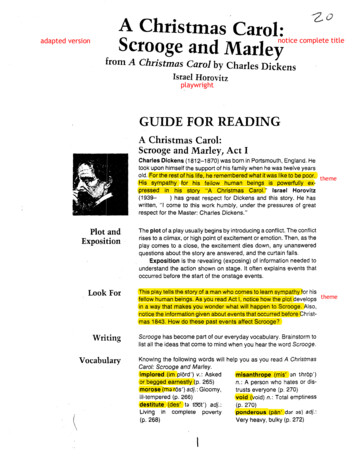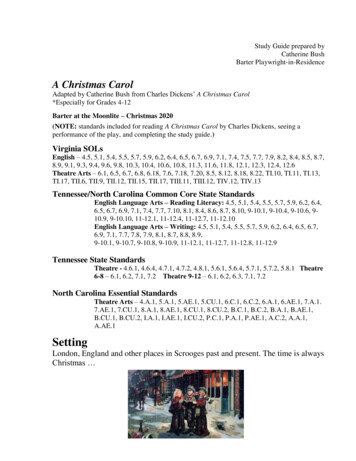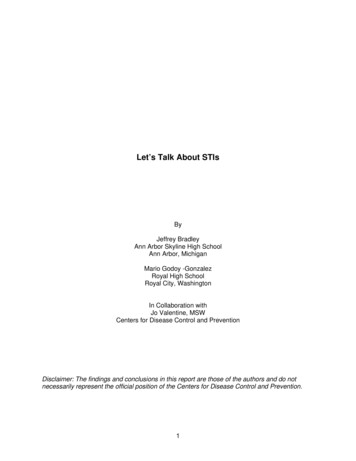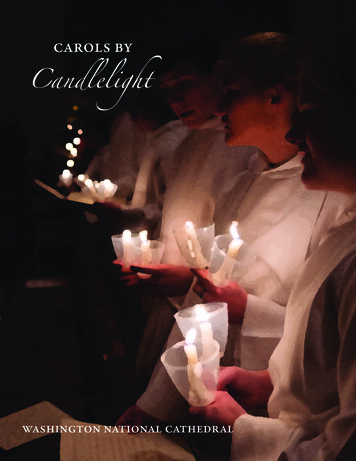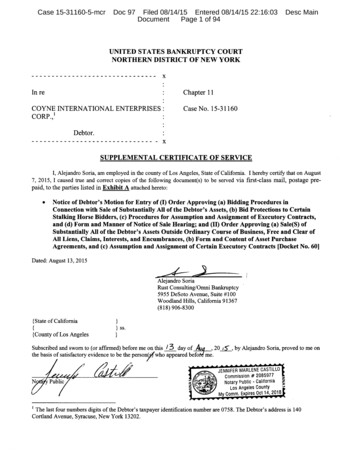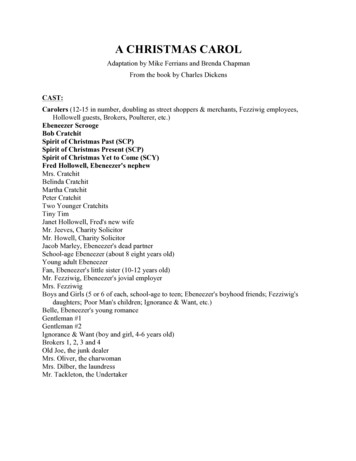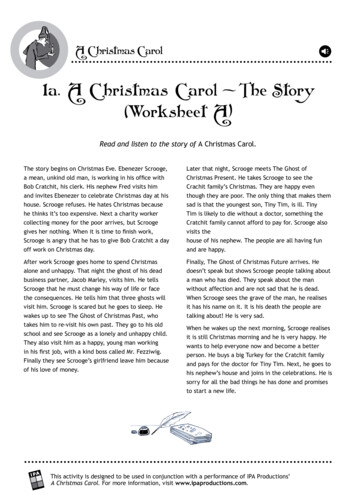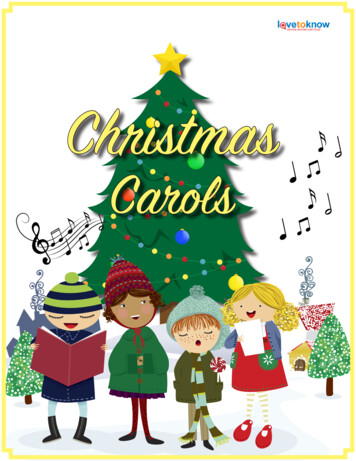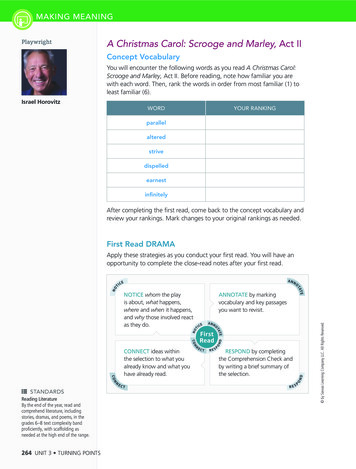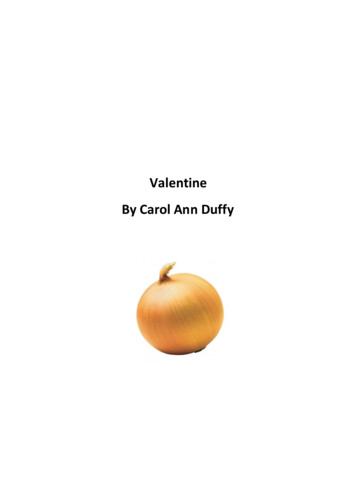
Transcription
ValentineBy Carol Ann Duffy
ONIONS! How are onions like love?We are going to the kitchen. You need:1. An onion2. Your imaginationSetting the scene: imagine today is Valentine’s Day. You are in love. You have a romantic date withyour boyfriend/girlfriend this evening. The produce a present for you: an onion.THE ONIONWhat does theoutside of theonion look like?Describe itsshape, colour,texture.Peel the brownor red skinfrom the onion.Now describethe onion.Describe shape,colour, texture.What objectswould youcompare it to?Your description of the onion (be as specific as possible. Use imagery if youcan.)
Now cut theonion in half.What effectdoes this haveon your eyes?Now taste theonion. Howwould youdescribe thetaste?What effectdoes the tasteof the onionhave on yourmouth or yourlips?Look at thecross section ofthe onion.Describe it.What objectscould youcompare thispart of theonion to?Now smell yourfingers.Describe thesmell.
ValentineNot a red rose or a satin heart.I give you an onion.It is a moon wrapped in brown paper.It promises lightlike the careful undressing of love.Here.It will blind you with tearslike a lover.It will make your reflectiona wobbling photo of grief.I am trying to be truthful.Not a cute card or a kissogram.I give you an onion.Its fierce kiss will stay on your lips,possessive and faithfulas we are,for as long as we are.
Take it.Its platinum loops shrink to a wedding ring,if you like.Lethal.Its scent will cling to your fingers,cling to your knife.Carol Ann Duffy
What is the poem about?The poem, on the surface, is about the giving of an unusual present for Valentine’s day, but it isreally an exploration of love and the nature of relationships between two people. The poem isuniversal: it could be any lover to any beloved as there is no indication of the sex of either the ‘I’ orthe ‘you’. This is a good poem to write about because it has a single central image, which isdeveloped throughout the poem: the onion is an extended metaphor for love.How is the presentation of love developed?The most important thing to mention and refer to when discussing this poem is that it is anEXTENDED METAPHOR; the poet compares her love and the relationship to an onion, this image isextended throughout the whole poem drawing similarities throughout.The speaker of the poem offers her lover an onion as a Valentine gift. This is clearly not aconventional gift like satin hearts or roses; nevertheless she gives an onion because it represents herlove in many different ways. She continues through the poem comparing different aspects of theonion to different aspects of her love.What is Duffy saying?Initially the poet is positive about the love she offers saying that it has many layers which promise ajoyful future:‘it is a moon wrapped in brown paper / it promises light’However, Duffy also points out that true and passionate love can be painful:‘blind you with tears / like a lover’She is really saying that she offers her lover an onion because it is l ike her love – it can be beautifulyet can also cause pain and upset. She points out that a powerful love is very difficult to forget andthat just like the lasting smell and taste of the pungent onion a relationship will remain firmly in themind of the partners, perhaps even long after it has ended:‘its fierce kiss will stay on your lips,’‘its scent will cling to your fingers’Duffy draws comparisons between the rings of an onion and a wedding ring:‘platinum loops shrink to a wedding-ring’This suggests that the longer the relationship continues the more serious it will become and perhapswill then lead to the ultimate commitment of marriage. However, there is also a suggestion that ifsomething “shrinks” it becomes less valuable and perhaps hints at the end of the relationship.Certainly the end of the poem is not as positive as the opening when there is a suggestion that onepartner may end the relationship:‘cling to your knife’.
How does Duffy use structure?The structure of a poem is the way in which a poet chooses to set the poem out, this includes rhymeschemes, rhythm patterns, word or sentence patterns and the way the lines are laid out.Duffy wants the receiver of her onion to know that she has chosen it because she feels that it is thebest and most genuine declaration of her love. Duffy rejects the traditional symbols of love becauseshe feels that they have become meaningless. The ‘satin hearts, ‘red roses’, ‘cute cards’ etc are notacceptable to Duffy because each has ceased to be original, they are stereotypical gifts which havebeen sent so many times that they have become superficial and insignificant.Notice how Duffy structures these lines to emphasis that she does not approve of these types of gift:‘Not a red rose or satin heart’And‘Not a cute card or a kissogram’In both cases the word ‘not’ is stressed because it appears first in the line (notice it is also the veryfirst word of the poem). Duffy adds impact to her point by repeating the structure of the lines, whichis identical, and also by having these lines standing alone in the poem.Also, Duffy is making a very personal and direct declaration of love. The message is sent from thespeaker to the intended lover with real clarity in the way that the words ‘I’ and ‘you’ are usedthroughout the poem. Furthermore, Duffy uses short lines to emphasis the emotional plea; you canalmost hear the speaker’s voice as they offer their gift of love in the lines ‘Here’, ‘Take it’, ‘I amtrying to be truthful’.The whole poem is written in FREE VERSE, which means that there is no obvious rhyme scheme orrhythm. This is an important choice because it echoes the naturalness of speech and also highlightsthat love and relationship have no order or pattern.How does the language chosen by the poet reflect the message of the poem?Duffy is very careful to choose words and phrases and images that express exactly what she feels.(Remember that in poetry you should always think about the deeper meanings of words, theconnotations – ideas associated with them – and be looking for examples of effective figurativelanguage).The early part of the poem suggests the positive aspects of the relationship. Think about the words‘promise’ and ‘light’, words linked with good things. Also look at how Duffy suggests the‘undressing’ of lovers through the image of removing the outer layers of the onion.As the poem progresses there is more focus on both the strength and power of the relationship;‘fierce’, ‘possessive’, ‘faithful’, yet also the pain and tears it can bring; ‘blind’, ‘tears’, ‘wobblingphoto of grief’. At the close of the poem, Duffy’s choice of language and image suggests that theintensity of the lovers may well be too much for the relationship, forcing an ending, ‘lethal’.Think about the last line, ‘cling to your knife’, this image suggests one partner cutting therelationship and therefore ending it.
What does the tone of the poem reveal about the poet’s attitude?The TONE is the way a speaker would say/read the poem. The tone can reve al a great deal about thespeaker’s attitude towards the subject, in this case Valentines and love.The tone is established through the language and structure. Thus in this poem the tone is DIRECTand SINCERE. The poet is making a heartfelt declaration of love to her lover, which begins in aPOSITIVE manner but develops and more SINISTER feel as the potential failure of the relationship isconsidered.Think about how the poet is rejecting stereotypical Valentine’s presents because they do not conveythe true strength of the relationship. Thus the poem has POWERFUL feeling as the poet explains allthe reasons that the onion is a more appropriate gift.
What is the poem about?Group TaskIn groups, using the information you have just read, complete the table below.NOTE: It is important to complete the table, as each group will be expected to answer any givenquestion.1.How does the poet portray relationships in thepoem?2.What is the tone (the way a speaker would readthe poem)? What does the tone show about thepoet’s attitude towards the subject?3.What is the importance, purpose and symbolismof the gift?4.How does the language reveal the message ofthe poem? Look carefully at the writer’s choice ofwords – why have these particular words beenchosen? Do they create a particular effect?
The Onion and LoveCarol Ann Duffy gives the onion as a gift and uses it to signify love and relationships. Complete thetable below, identifying what the onion is or does, and in what ways this is similar to relationships.The OnionLove/Relationships‘It is a moon wrapped in brown paper. The ‘brown paper’ is the outer skin of the onion, theIt promises light.’comparison also supports the ideas of a gift. The referenceto the ‘moon’ is common in romantic poetry, it ‘promiseslight’ like the moon, and perhaps, like the optimism at thebeginning of a new relationship.‘It will blind you with tearslike a lover.’‘It will make your reflectiona wobbling photo of grief.’
‘Its fierce kiss will stay on your lips,possessive and faithful.’‘Its platinum loops shrink to awedding-ringif you like.’‘LethalIts scent will cling to your fingers,Cling to your knife.’Remember: Because Duffy writes about her relationship as if it is an onion, we can say that she usesa METAPHOR. Because she returns to the image over and over again, and continually develops thecomparison, we can refer to the language device as an EXTENDED METAPHOR.The table that you have completed illustrates how the extended metaphor works in both itsrepresentation of love, and also the development of the image.
Valentine – A SummaryUsing the work you have done so far, complete the following passage by copying out and filling inthe spaces with the appropriate words. The passage is divided into four paragraphs and each oneconsiders a different aspect of the poem.Subject Matter – What the poem is aboutThe title of the poem tells us that it is a. However, straight away, we learnthat it is not a normal type of Valentine, it is ‘Not athe poet gives her lover an‘. Insteadas a sign of her love. She explains why the gift is soappropriate using original romantic images like, ‘‘. There isalso a note of caution; relationships can be killed off, and love can be, ‘‘.Ideas and Attitudes – What the poem is trying to sayCarol Ann Duffy rejects the usual Valentine gifts, suggesting that they are tooInstead, she provides what she considers to be a far more.representation oflove and relationships.She implies that love is not always sweet, but can be sharp, cutting and can result in tears, just likethe scent and taste of an.Language – The words that are usedThe poet uses an extended, she writes about her relationship as if itwas an onion. She considers the qualities of an onion, and how these are similar to those of arelationship, for example, ‘because‘ can be compared to a love affair.Apart from these comparisons, the language tends to be quite simple and straightforward. Perhapsthis means that she wants her relationship to beas well.
The poem also contains a number of statements, for instance, ‘‘.This makes the poet sound in control and sure of herself.Form or Structure – The way the poem is set outThe poem does not have a regular structure. The lines and stanzas are of varying length. This couldbe for several reasons. Firstly, thatcan not be ordered and regular. Secondly,that the poet’s thoughts are going directly onto paper, she is notthem first,just like a relationship cannot be planned.Also, traditionalpoetry is very regular and so she may have deliberately decided toreject this form.Finally, some important words and short phrases have a line or stanza all to themselves. This servesto.
The whole poem is written in FREE VERSE, which means that there is no obvious rhyme scheme or . scheme or rhythm. This is an important choice because it echoes the naturalness of speech and also highlights that love and relationship have no order or pattern. . (Remember that in poetry
